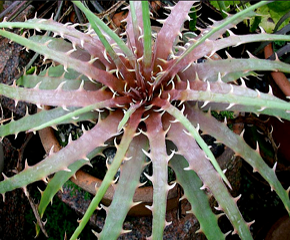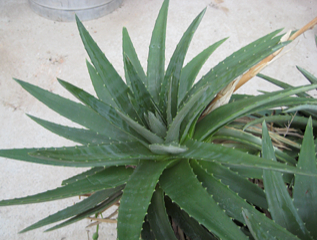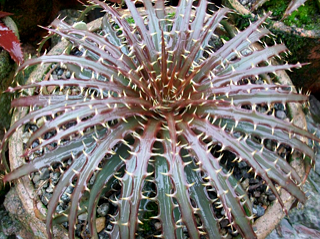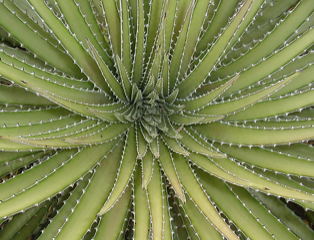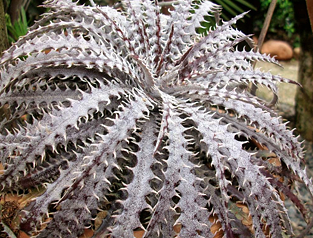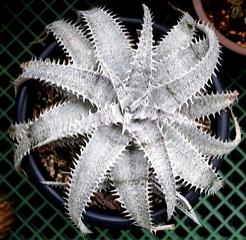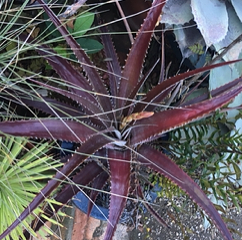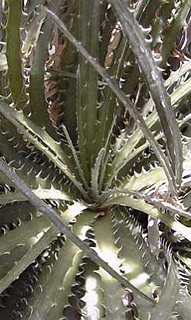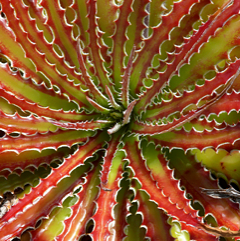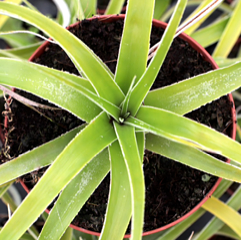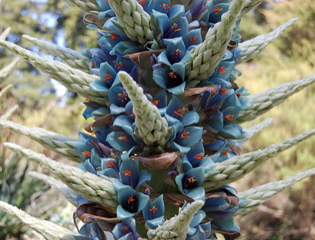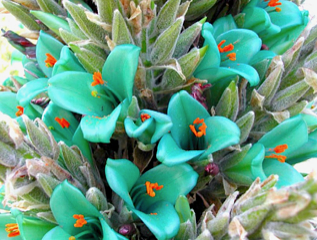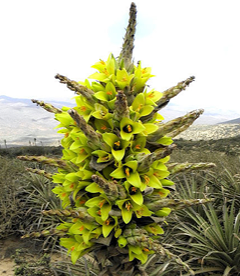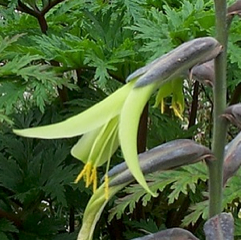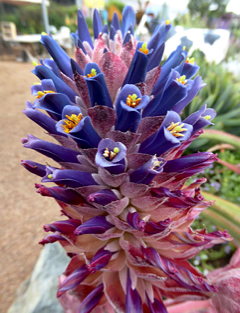Submitted by: Jim Tanner
Dyckia is a genus of 120 terrestrial bromeliads native from Brazil and central part of South America. Dyckia have stiff leaves and are generally spiny. They live in rocky and/or sunny areas. Most species clump readily forming large mats.
They are relative of the pineapple and are relatively easy to grow. They should be grown as other succulents in a well drained soil. Good cactus soil or African violet soil is adequate. They like a lot of water in summer, and need a lot of space in their pot to accommodate their large root system. A lot of sunlight is a necessity.
Flowers are generally yellow to orange and come from the side of the rosette.
Hechtia is a genus of about 50 species belonging to the pineapple family. It is related to the genera Dyckia, Hechtia, Pitcairnia and Puya. They have long, stiff, spiny-toothed leaves in dense rosettes and clusters of small white flowers.
Hechtias are terrestrial bromeliads, and they require copious amount of water and fertilizer to prosper. They are originating from dry areas of Texas thru Central America, but almost all the species are native to Mexico. Most of the species are extremely frost tender. They tend to have a large root system, and generally need to be overpotted.
Hechtias are dioecious, so a male plant and a female plant are needed to produce seeds.
There are about 168 species of Puya, native mostly from the Andes mountains, but also from other parts of South and Central America. This genus contains some of the largest Bromeliads, some species reaching 16 feet (5 m): Puya raymondii.
Puya have often showy flowers on large spikes or panicles.
LATIN LOOKUP – Loquerisne Latine (Do you speak Latin)?
The meanings of latin plant names on this page – from https://davesgarden.com/guides/botanary/
- alpestris [al-PES-triss]
From lower mountains. - brevifolia [brev-ee-FOH-lee-uh]
Short leaves. - chilensis [chil-ee-EN-sis]
Of or from Chile. - dawsonii [daw-SON-ee-eye]
Named for Jackson T. Dawson, 20th century superintendant of the Arnold Arboretum in Boston, Massachusettes (U.S.). - Dyckia [DY-kee-uh, DIK-ee-uh]
Named for Prince Joseph Salm-Reifferscheid-Dyck, 19th century botanist and author of book on succulents. - fosteriana [fos-ter-ee-AY-nuh]
Named for Mulford Bateman Foster, 20th century American horticulturist who provided many specimens to the botanist Lymen B. Smith. - maritima [muh-RIT-tim-muh, mar-ih-TEE-muh]
Of or from the sea. - marnier-lapostollei [MAR-nee-air lah-pos-STOL-ee-eye]
Named for Julien Marnier-Lapostolle, famous 20th century French plant collector. - mirabilis [mih-RAB-ih-liss]
Wonderful. - rosea [RO-zee-uh]
Rosy. - stenopetala [sten-oh-PET-al-uh]
From the Greek stenos (narrow) and petalum (petal). - texensis [teck-SEN-sis]
Of or from Texas (U.S.). - tillandsioides [til-land-see-OY-deez]
Similar to Tillandsia, a Bromeliaceae. - venusta [ven-NUSS-tuh]
Beautiful, charming.
